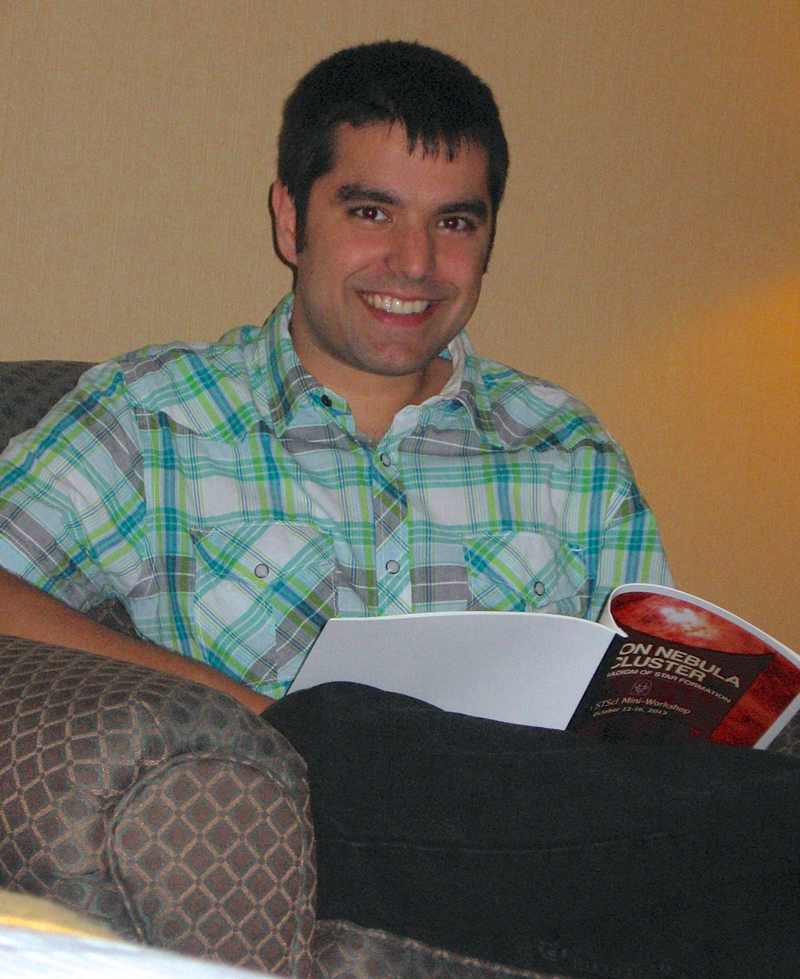
PhD: Universidad de Warwick, UK.(2012)
Research Area: White dwarfs, low-mass stars, compact binaries, eclipsing binaries.
Publications: ADS
Telephone: (+56 32) 299 5557
email: steven.parsons at uv.cl
About my research: I study binary star systems containing at least one white dwarf component. My main focus is high-precision studies of eclipsing systems, combining both high-speed photometry and high-resolution spectroscopy to determine ultra-precise fundamental parameters for both stars in the binary. The eclipsing systems also allow us to search for planets in orbit around the binary by timing the eclipses and observing any long-term trends in the eclipse arrival times. I also utilise large surveys, such as the Sloan Digital Sky Survey and the Catalina Real-time Transient Survey in order to discover new eclipsing systems. I am also searching for close binaries containing white dwarfs with more massive FGK-type main-sequence companions, since these are possible supernova Ia progenitors

PhD: Doctorado en Ciencias (Astronomía), Instituto de Astronomía-UNAM, México
Research Area: Cosmology, Dark matter, Dark energy, Scalar field Cosmology, Numerical Simulations..
Publications: ADS
Telephone: (+56 32) 299 5557
email: juan.magana at uv.cl
About my research: My research is focused on Cosmology, mainly, alternative models of dark matter and dark energy. I investigate a cosmological model which the dark matter is a scalar field or a Bose-Einstein condensate, lately I have focused in the numerical simulations of scalar dark halos. In addition, I study dynamical dark energy models and put constraints on their parameters using several cosmological data

PhD: Nicolaus Copernicus Astronomical Center, Warsaw, Polonia (Septiembre de 2010)
Research Area: infrared astronomy, very low mass stars, brown dwarfs, cool atmospheres, stellar formation, stellar clusters, Milky Way, binaries
Publications: ADS
Telephone: (+56 32) 299 5557
email: mairusz.gromadzki at uv.cl
About my research: My main research projects are connected to the search and characterisation of very low mass stars and brown dwarfs in the solar neighborhood. Nearby objects generally have larger proper motions than more distant ones and I am searching for such high proper motion targets towards Galactic bulge and Galactic disk based on the VISTA-VVV survey. I am also involved in near-IR spectroscopic and photometric follow up of new Y dwarfs candidates detected only in WISE W2 band.

PhD: The Pennsylvania State University, Pennsylvania, USA (2014)
Research Area: Star Formation, Star Clusters, Galactic Astronomy, X-ray Astronomy, IR Astronomy, Astrostatistics, Statistical Modelling
Telephone: (+56 32) 250 8457
email: michael.kuhn at uv.cl
Webpage: http://ifa.uv.cl/~mkuhn/
About my research: My work focuses on the formation of stars and young stellar clusters. Most stars are born in clusters along with hundreds to thousands of other stars--for example it is likely that the Sun was born in such an environment. I use observations across the spectrum of light, including infrared and X-ray, to study the young stellar clusters in our Galaxy and make a census of their newborn stars. There are a number of open questions about how stars form, motivated by different theoretical models of for stellar cluster formation. By studying the populations of young stars, we can constrain models for how star-formation progresses (e.g. Do clusters form suddenly or gradually?) and the fate of young embedded clusters (e.g. Which environments produce bound open clusters?) in star-forming regions. I am interested in the use of spatial statistics to learn about subclustering, dynamical relaxation, cluster expansion, and mass segregation, and non-coeval star-formation history in star-forming regions.

PhD: Universidad de Utrecht, Holanda (2011)
Research Area: protoplanetary disks, transition disks, planet formation, high-contrast imaging, imaging polarimetry.
Publications: ADS
Telephone: (+56 32) 299 5551
email: hector.canovas at uv.cl
About my research: My main research area focus on the study of protoplanetary disks, and in particular, transition disks. As an observer astronomer, I use high contrast imaging techniques to directly image the faint protoplanetary disks at optical wavelengths, near infrared and millimeter wavelengths (ALMA). I’m also interested in studying the fraction of close binaries in transition disks





